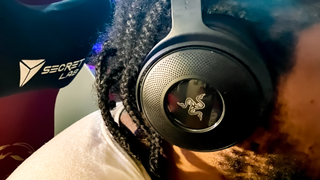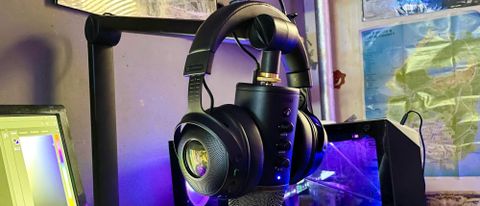Tom's Hardware Verdict
The Razer Kraken V3 Pro is the best of the bunch, retaining everything that made previous models great and improving on what held other models back. But the price may not be worth the additional features for some.
Pros
- +
+ Wireless
- +
+ Lightweight materials
- +
+ Comfortable ear cup design
- +
+ Detachable Mic
- +
+ THX Spatial
- +
+ Wide range of compatibility
Cons
- -
Pricey for the addition of wireless and haptic feedback Hypersense feature
- -
Left ear cup is cluttered
- -
Can’t charge and use at the same time
Why you can trust Tom's Hardware
The Razer Kraken V3 Pro is the fourth and most premium headset within the Kraken V3 family. It contains all the incremental features included individually across the product range and, as a plus, cuts the cord entirely for a wireless approach. It features the range’s hybrid fabric and leatherette memory foam ear cushions, Razer’s TriForce titanium 50mm drivers, and the same THX Spatial Audio capabilities found in the previous three models. The V3 Pro also includes an improved detachable HyperClear “Supercardioid” Mic and 3.5mm analog.
It’s no surprise from my Razer Kraken V3 review that I feel as if the entire range could have lost a headset or two to slim down the family and consolidate a few more of those incremental features. Why is wireless only available on the most expensive model? I’m sure some people want to cut the cord but don’t care about haptics.
Alongside more connectivity options and quality of life improvements, the Razer Kraken V3 Pro is easily one of the best wireless headsets we’ve ever reviewed. But it’s also very likely to offer more than you’ll need.
Specifications - Razer Kraken V3 Pro
| Driver Type | 50 mm |
| Impedance | 32 Ohms |
| Frequency Response | 20 Hz - 20,000 Hz |
| Microphone Type | Detachable HyperClear Cardioid Mic |
| Connectivity Options | USB-A, headphone jack |
| Cables | Detachable Mic, 1.3m/4.27ft Cable detachable |
| Weight | 13.12oz / 372g |
| Lighting | 2 RGB on Earcups. |
| Software | Razer Synapse |
| Extra | None |
Design and Comfort of Razer Kraken V3 Pro





The look, design and comfort of the Razer Kraken V3 Pro don’t stray too from its vanilla counterpart. It’s an all-black affair with RGB flair on each cup that can be customized through the Synapse app. The lighting pops great on the headset, and its unlimited color options can enhance the ambiance of any RGB-powered setup.
The hybrid fabric and memory foam used on the ear cushion and adjustable headband feel spectacular. The headband feels so plush on my head that I often can’t tell that it’s there. I wore the headset for a complete workday and my ears never got hot, plus I never felt the need to take a break from wearing them.
I’ve got a big head, so I had to adjust the headband for the headset to fit. Eight small numbered spaces inside the headband show how much it can expand. There’s a tactile click that firmly expands the headband and also keeps it from sliding down your head once set. The wireless aspect also plays a factor in being comfortable to wear all day. The wireless signal was able to stay strong as I got up to check my front door 25 feet away, but it wasn’t strong enough to keep a connection further into my kitchen, which was about 35 feet away.
The difference between the Kraken V3’s design and the Pro’s is in the number of ports and buttons it has on each earcup. The Pro has a mute button at the bottom-left of the left cup. Below it is the volume wheel and below that is a power button that has a play/pause function. A 3.5mm headphone jack (a cable is included in the box) is also there for supplementary connectivity with more traditional audio listening devices. Below is a USB-C port, which is needed for the headset’s 4.27ft cable to connect to a PC for charging. Unfortunately, the Pro can’t charge and be used simultaneously on PC (plus the cable would be a little too short if it could). What’s worse, it takes the headset three hours to get a full charge. Lastly, below the USB port is an additional jack to plug in the Razer’s detachable HyperClear Cardioid microphone.
All of those ports and buttons clutter the left side of the earcup. I would rather have a button or input port placed on the right side of the headset, which only houses the button to turn off or activate Razer’s Hypersense feature.
Audio Performance
The V3 and V3 Pro both utilize Razer’s TriForce Titanium drivers, are 50mm in size, and produce the same 20 Hz – 20 kHz frequency response. The V3 Pro’s sound is just as phenomenal as its vanilla counterpart. Everything instantly sounded crisp before I meddled with the audio via Razer Synapse. I listened to a fan-made edit of “All for Us” by Zendaya and Labrinth that only focuses on the former, and for the first time, I could audibly notice sections of the track sounding that were mixed down to serve the purpose of the edit.
After that, I tweaked around a bit with the headset’s software to see how I could really get the most out of the already stellar sound. There are three settings in the audio
“Enhancement” section of Razer Synapse, each with its own slider to adjust the effect. One is for bass boost, another is sound normalization, which regulates volume, and the last is for vocal clarity. There’s also a separate equalizer with gaming, music, and movie presets. A separate preset is also available to save custom equalizer settings. I used the music preset first. I used Spotify to listen to “Gone Guru” by Lifeseeker with sound normalization at 50, and it brought the track to life. The vocal-heavy track sounded clearer than I’d ever heard it. Where the track sounded a bit flat in my Sennheiser Momentum TW2 earbuds, the instrumentation and vocals sound like a remaster after some software tweaks on the V3 Pro software.
As usual, I listened to “Deep Down” by Winter Kills to test the equalizer and music preset in the software to find the best music-listening experience. The track has just the right amount of soft vocals, deep bass, and heavy kicks to determine highs, lows, and mids. I used similar configurations, 25 Bass/50 Sound Normalization, as I did for the base V3, and sound replication was the same, which is to say: godly. I also made sure to go into Spotify's settings and turn on the “Loud” volume option. Despite this song’s emphasis on euphoric vocals, I found that the vocal clarity mode works best for video conferences or podcasts where someone is speaking, as opposed to vocal-heavy tracks. Vocal clarity didn’t fare as well with music, so I would suggest tweaking the EQ to enhance vocal tracks instead.
There were random moments when using the regular V3 where I’d get feedback, and since I started reviewing the Pro, I haven’t experienced feedback even once. When using FL Studio, I maxed out the master volume well into the red, and I still never got any feedback issues.
The volume wheel on the headset controls the volume inside the headset, as opposed to adjusting the playback volume like the standard V3. I love it for that, and I love having volume control outside of the master sound channel from the PC. I tested this out on consoles as well, such as the Nintendo Switch and Xbox One X. Here, the volume wheel only adjusted the sound inside the headset instead of the volume from the consoles.
Of course, this is a gaming headset, so I booted up Cyberpunk 2077 to test the audio in-game. THX spatial audio was a treat here, and I could easily make out the origin points for my footsteps and the footsteps of others in a full 360-degree circle around me. I’m not big on multiplayer titles, but I could imagine how beneficial this headset would be in a competitive sense.
Haptic Feedback

The Razer Kraken V3 Pro comes with a haptic feedback feature called Hypersense that turns sound into rumbles in each ear cup for another layer of immersion during gaming. The feature is only available when the headset is wireless and is disabled when connected via the 3.5mm jack. There are three settings for haptic rumbles: low, medium, and high, each of which you can cycle through with the push of the button. I found the low option to be the least intrusive setting, as anything stronger took me away from focusing on the game. I first tried the Hypersense feature while playing Cyberpunk 2077, which also utilizes THX Spatial audio. The game itself is bombastic, from the roaring engine of your car while traversing Night City to the loud pedestrians you pass, the music, and even footsteps in some instances. The headset picks up every little sound and rumbles incessantly as a result. Even on the low setting, it was too much and took me out of the game rather than immersing me in it.
The feature is more welcome in single-player action adventures like God of War, or in a survival horror title. For God of War, haptic feedback gave weight to each swing from Kratos’ axe and made the game feel more cinematic. The impact from every little sound makes it feel like you haveIMAX loudspeakers on your head, for better or worse. It also raised the shock value in sections of Resident Evil 7 that made the jumpscares more effective, given those scares focus on sound. But using Hypersense during loud games, especially ones with guns, gave me a headache.
Compatibility
USB connectivity works instantly over PC, and once I plugged the Kraken V3 Pro into my PS4 and navigated to the audio settings, the headset connected instantly without me having to do anything. The connection over the headphone jack was also simple enough. A cable is included for the headphone jack and it connected to my Nintendo Switch without a problem. However, getting the V3 Pro connected to an Xbox was a bit of a hassle.
Just plugging it in allows you to use the microphone without a problem, which means you can speak in any game with built-in chat functions at the ready. But due to the way the Xbox interface is set up, you have to fiddle with menus to hear in-game audio via the headset. I ultimately had to start a Chat party by myself to access the chat mixer settings to adjust how much game audio I heard versus chat audio. It took me 20 minutes to figure it out, and even then, I had audio coming out of the TV and the headset, with no real instructions on how to do it perfectly.
Razer’s headsets are known for not being as compatible with Xbox consoles, and the Kraken V3’s instructions don’t show how to connect to them. The instructions don’t even show an illustration of an Xbox alongside other compatible devices because Razer knows it’s not plug-and-play. But it’s technically doable, and since the V3 Pro is the only model within the 2021 Kraken family that is compatible with Xbox consoles, there should be a note about how to connect to one specifically.
Microphone

The Razer Kraken V3 Pro comes with a detachable microphone similar to the rest of the headsets in this line, except this time with an improved supercardioid pick-up pattern. A standard cardioid pattern was used with the V3’s detachable mic, which picks up sound in a wide, frontal heart-shaped direction. Supercardioid tightens up that heart-shaped pick-up pattern while improving side-rejection. There was an immediate quality difference when I recorded my voice on Audacity with the V3 Pro microphone vs the older one. My voice sounds a lot more present when using the latter, and although both produced a fuzzy feedback noise each time I spoke, it was less noticeable on the Pro’s.
However, the microphone itself still isn’t anything to write home about. It’ll get the job done if you need a microphone for in-game chatting or to talk to your friends over Discord, but don’t expect the sort of clarity you’d find from the best microphones on desktop. Of course, the software’s mic settings allow you to tweak its noise gate, vocal clarity, and volume normalization. And presets like Mic Boost, Conference, and Broadcast are available and do make a difference after some personal tweaking. For instance, I used Mic Boost when live streaming and could be heard loud and clear over the game’s audio when I couldn’t be heard beforehand.
Software
Like the other headsets within the Razer Kraken family, the V3 Pro utilizes Razer Synapse to customize its RGB lighting or make adjustments to the mic/audio quality. The tabs for the V3 include a general Sound section for assigning sound properties, a Mixer to set THX Spatial settings to individual apps, and unlabeled tab for testing the calibrations of the headset’s Game, Music, and Movie Mode presets, Enhancements for audio settings, Mic for microphone settings, and Lighting to tune RGB colors.
Although the software does a lot to elevate the product, it can be buggy at times. After some prolonged use, it messed with my sound drivers, and I had to do a fresh install of all my audio drivers. Despite this, Synapse’s user interface is simple enough to understand and has enough practical features to make it more than useful.
Bottom Line

The Razer Kraken V3 Pro is undeniably the best headset of the Kraken family, as it should be given its expensive price point. Although I disagree with the stiff price for the addition of wireless capabilities and Hypersense haptics, not being tied down by a cable plus the wide variety of compatible devices puts the V3 Pro over the top. It has everything I love from the standard V3, addresses the issues I didn’t like about it, and adds all the features from across the product range. But with that comes some issues that are unique to the Pro, like the overly cluttered left earcup and not being able to use the headset while charging it.
Despite some minor grievances, the sound quality remains supreme, and its stylish design is retained. All the while maintaining its focus on delivering immersion without sacrificing comfortability. If haptic feedback and THX Spatial audio isn’t your main concern when shopping for a headset, the Corsair Virtuoso RGB Wireless SE Headset may be a better choice thanks to its superior 10Hz-40KHz frequency response.

Isaac Rouse is a staff writer at Tom's Hardware. He reviews laptops and various gaming peripherals.
